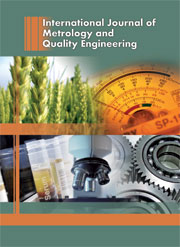Crossref Citations
This article has been cited by the following publications. This list is generated based on data provided by
Crossref.
Elkarous, Lamine
Robbe, Cyril
Pirlot, Marc
and
Golinval, Jean-Claude
2016.
Dynamic calibration of piezoelectric transducers for ballistic high-pressure measurement.
International Journal of Metrology and Quality Engineering,
Vol. 7,
Issue. 2,
p.
201.
Sahoo, Debasis
Robbe, Cyril
Deck, Caroline
Meyer, Frank
Papy, Alexandre
and
Willinger, Remy
2016.
Head injury assessment of non-lethal projectile impacts: A combined experimental/computational method.
Injury,
Vol. 47,
Issue. 11,
p.
2424.
Nikfar, Farzad
and
Konstantinidis, Dimitrios
2017.
Evaluation of Vision-Based Measurements for Shake-Table Testing of Nonstructural Components.
Journal of Computing in Civil Engineering,
Vol. 31,
Issue. 2,
Revtova, Elena
Vuelban, Edgar Moreno
Zhao, Dongsheng
Brenkman, Jacques
and
Ulden, Henk
2017.
Traceability validation of a high speed short-pulse testing method used in LED production.
International Journal of Metrology and Quality Engineering,
Vol. 8,
Issue. ,
p.
30.
Shahadat, Shams M.
Huang, Yih-Ru
and
Dyer, John W.
2018.
A novel stereo vision tracking system used in air traffic collision risk model.
p.
1.
Robbe, Cyril
Papy, Alexandre
and
Nsiampa, Nestor
2018.
Using Kinetic Energy Non-Lethal Weapons to Neutralize Low Small Slow Unmanned Aerial Vehicles.
Human Factors and Mechanical Engineering for Defense and Safety,
Vol. 2,
Issue. 1,
Nsiampa, N.
Robbe, C.
and
Papy, A.
2018.
Non-lethal Projectile Characterisation Method: Application to 40-mm SIR-X and Condor NT901 Projectiles.
Human Factors and Mechanical Engineering for Defense and Safety,
Vol. 2,
Issue. 1,
Robbe, Cyril
Papy, Alexandre
and
Nsiampa, Nestor
2019.
Toward a Reference Non-Lethal Projectile to Validate Blunt Trauma Injury Evaluation Models.
Human Factors and Mechanical Engineering for Defense and Safety,
Vol. 3,
Issue. 1,
Maresca, P.
Duarte, Á.
Wang, C.
Caja, J.
and
Gómez, E.
2019.
Evaluation of traceability in continuous 2D measurements employing machine vision systems.
Procedia Manufacturing,
Vol. 41,
Issue. ,
p.
922.
Johnson, Kristyn
Ferguson, Donald H.
and
Nix, Andrew C.
2021.
Individual Wave Detection and Tracking within a Rotating Detonation Engine through Computer Vision Object Detection applied to High-Speed Images.
Li, Jian
Chockalingam, S
and
Cohen, Tal
2021.
Observation of Ultraslow Shock Waves in a Tunable Magnetic Lattice.
Physical Review Letters,
Vol. 127,
Issue. 1,
Mao, Ning
Kang, Can
Ding, Kejin
and
Cao, Qian
2021.
Gas-liquid two-phase flow patterns in the wake of a submerged nozzle under co-flow condition.
International Journal of Multiphase Flow,
Vol. 138,
Issue. ,
p.
103604.
Farrimond, Dain G.
Rigby, Sam E.
Clarke, Sam D.
and
Tyas, Andy
2022.
Time of arrival as a diagnostic for far-field high explosive blast waves.
International Journal of Protective Structures,
Vol. 13,
Issue. 2,
p.
379.
Holmes, A.
Toic, A.
Ewing, D.
Fujisawa, N.
and
Ching, C. Y.
2022.
Effect of an electrolyte (MgSO4) on the boiling flow regime and heat transfer for water at low heat flux and low pressure.
Heat and Mass Transfer,
Vol. 58,
Issue. 3,
p.
481.
Xie, Wenbo
Zhang, Wei
Yang, Hongbin
Wei, Hongjian
Wang, Lina
Gao, Yubo
and
Cai, Xuanming
2022.
Experimental investigation of high velocity impact response of CFRP laminates subjected to flyer plate impact.
Thin-Walled Structures,
Vol. 178,
Issue. ,
p.
109521.
Shedd, D. F.
Berthelson, P. R.
Rifkin, J. A.
McMahon, J.
Giudice, J. S.
Forman, J. L.
and
Panzer, M. B.
2022.
The Risk of Skin Injury Caused by High-Rate Blunt Impacts to the Human Thorax.
Human Factors and Mechanical Engineering for Defense and Safety,
Vol. 6,
Issue. 1,
Atoui, Oussama
Kechagiadakis, Georgios
Moumen, Abdelhafidh
Maazoun, Azer
Belkassem, Bachir
Pyl, Lincy
and
Lecompte, David
2022.
An Explosive Driven Shock Tube-Based Laboratory Scale Test for Combined Blast and Fragment Impact Loading.
Applied Sciences,
Vol. 12,
Issue. 14,
p.
6854.
Georgalis, Georgios
Retfalvi, Kolos
Desjardin, Paul E.
and
Patra, Abani
2023.
COMBINED DATA AND DEEP LEARNING MODEL UNCERTAINTIES: AN APPLICATION TO THE MEASUREMENT OF SOLID FUEL REGRESSION RATE
.
International Journal for Uncertainty Quantification,
Vol. 13,
Issue. 5,
p.
23.
Johnson, Kristyn B.
Ferguson, Donald H.
Nix, Andrew C.
and
Tallman, Zachary
2023.
Wave Detection and Tracking Within a Rotating Detonation Engine Through Object Detection.
Journal of Propulsion and Power,
Vol. 39,
Issue. 4,
p.
612.
Stirbu, Bogdan
Ndindabahizi, Irene
Vancaeyzeele, Tom
and
Robbe, Cyril
2023.
Energy balance model to assess the resistance of ballistic protection materials.
Defence Technology,
Vol. 30,
Issue. ,
p.
141.


